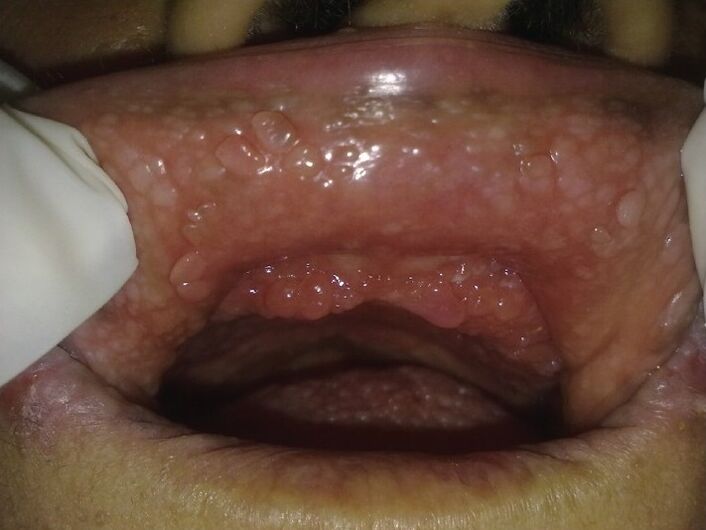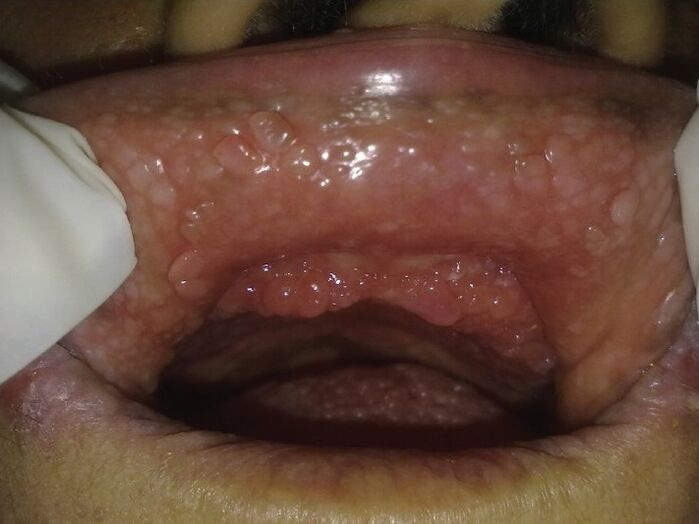
Papillomas (or warts) are not so common in men.
Usually they do not cause pain, but they need treatment because they pose a danger to both the owner and those around him.
What is this
A papilloma is a growth caused by excessive cell division of the epithelium of the skin or mucous membrane.
Its appearance is caused by the papillomavirus - it changes the DNA of human cells, causing them to reproduce intensively.
Human papillomavirus (HPV) is a very common microorganism.
It has been determined that about half of the adult population is a carrier of one or another strain or has clinical manifestations of the disease.
A person can encounter a virus every day and not get sick thanks to an active immune defense. However, a decrease in resistance can make the body vulnerable.
To date, more than 100 types of HPV have been identified.
What papilloma looks like on the skin: treatment and prevention of papillomavirus infection
The external manifestation of the human papillomavirus is papillomas on the skin. Popularly called warts, neoplasms are benign. But an apparently harmless growth can turn into a malignant tumor and become a cancerous tumor.
Why do papillomas appear on the skin?
You can get the virus by contact with a carrier of the strain or by household contact when using contaminated items.
The cause of papillomatosis in newborns is when the mother passes through the infected birth canal.
HPV infection also occurs under the influence of negative factors such as:
- weakening of the immune system;
- sex life with unapproved partners;
- bad habits;
- long-term treatment with certain drugs;
- tendency to depression;
- infectious diseases;
- non-observance of hygiene rules in public places with high humidity conditions.
When HPV, which is the main cause of the formation of papillomas on the skin, enters the body, it affects the basal layer of the epithelium at the point of its transition from multilayer to cylindrical form. As a result, the infected cell becomes benign, but can later regenerate and start the cancer development mechanism.
A peduncular neoplasm deserves special attention - due to its sensitivity to damage, it can infect the surrounding healthy skin and cause multiple papillomatosis.
Warts do not always turn into tumors. If they are caused by viruses with low oncogenicity, do not worry. These are strains 42, 44, 11 and 6. A dermatologist or venereologist can determine the degree of oncogenic risk.
Diagnosis of papillomatosis
What does papilloma look like on the skin? The standard choice is a rough, soft growth that looks like a mushroom or cabbage inflorescence. Its size can reach 2 cm.
Neoplasms are divided into the following types:
- simple - these are coarse hard growths starting from 1 mm in size. They tend to accumulate in arrays under a single stratum corneum. Such papillomas are formed under the knees, behind the fingers and palms.
- Similar to calluses, plantar warts are small shiny bumps. Over time, they grow and are distinguished by a characteristic protruding ring. Branches separate from the main growth in the form of small baby warts.
- Filamentous growths resemble elongated conical rods up to 6 mm in length.
- Flat neoplasms are characterized by the natural shade of the body and the resemblance to flat cones. If they are present, people complain of itching, sometimes - redness of the focus.
- Genital warts are new growths that appear on the genitals of men and women. They affect the skin and mucous membranes. The color of genital warts is fleshy, pink, red. Sizes vary from 1 mm to several centimeters.
After the visual examination of the patient, the specialist sends him for PCR diagnosis of the DNA of the virus. According to their answers, the doctor will be able to determine the type of strain, its degree and amount of oncogenicity. PCR also allows you to understand whether papillomatosis is chronic or suddenly appears against the background of a sharp decrease in immunity.
Micropreparation of skin papilloma is represented by connective tissue stroma and epithelium. The nature of the latter determines the type of squamous and transitional cell neoplasm. The connective tissue of the stroma is defined as dense or loose. It often turns out to be edematous, inflamed and full of blood vessels. Fibropapilloma is diagnosed in the case of growth sclerosis.
The epithelial layer surrounding the warts shows an increase in the number and size of pathological cells. This is an indication of hyperkeratosis. Papillomas can differ from each other according to their histological structure.
For example, areas of parakeratosis and vacuolated epithelial cells are characteristic of common skin papillomas. Formations with polymorphism of epithelial cells are identified in aged keratosis. In ICD 10, skin papilloma is listed under code B97. 7 "Papillomaviruses as causes of diseases classified elsewhere".
Treatment and prevention of human papillomavirus infection
HPV treatment regimens are always selected individually by doctors. If a virus is detected before clinical manifestation, the patient is offered the use of cytostatics.
Based on specific symptoms and localization, treatment of papillomas on the skin is carried out according to one of the following methods:
- cryodestruction;
- radio wave therapy;
- electrocoagulation;
- laser vaporization;
- chemical destruction.
Warts with signs of degeneration are subjected to surgical excision with involvement of healthy tissues. After the removal of external signs of papillomavirus carrier, the patient is prescribed a course of antiviral therapy and regular examinations are offered.
As a conservative therapy, drugs are prescribed that inhibit the activity of the virus and increase the body's defenses.
The drug released in the form of a spray is a topical preparation. Its use has an antiviral and immunomodulatory effect. The spray is included in the complex therapy of genital warts.

Prevention of HPV infection has several directions. The most important of them is the sexual education of young people by explaining the transmission characteristics of the virus and methods of protection. Special attention is paid to a healthy lifestyle, development of resistance to stress and timely treatment of any infectious disease.















